Categories: Featured Articles » Electrician Secrets
Number of views: 88713
Comments on the article: 10
What happens in the mains when a zero break
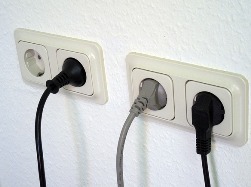 All residents of the entrance, or rather, the left riser, a nine-story house built in the 80s were in trouble: suddenly the motors of old refrigerators, washing machines, power supplies for computers, cordless phones and some other household appliances burned out. True, one person noticed that the light bulbs increased sharply and quickly reacted - turned off the opening automatic power supply.
All residents of the entrance, or rather, the left riser, a nine-story house built in the 80s were in trouble: suddenly the motors of old refrigerators, washing machines, power supplies for computers, cordless phones and some other household appliances burned out. True, one person noticed that the light bulbs increased sharply and quickly reacted - turned off the opening automatic power supply.
The rest are out of luck. Many were generally at work and could not do so. They learned about the incident in the evening. Of course, they began to turn to the housing and communal services, demand explanations, compensation for damage ...
The director of public utilities got into the situation and was forced to satisfy most of the requirements: he paid for the repair of expensive equipment, but after submitting various documents and certificates. How much time and nerves it took for people is better not to describe.
The reason for what happened is simple. A team of electricians performing preventive maintenance of electrical equipment made a gross mistake. The manufacturer did not control the work, and the trainee electrician independently tore the “zero” three-phase power supply.
The process of power transmission during normal connection in a four-wire system is shown in the figure.
The normal mode of operation of the four-wire circuit:
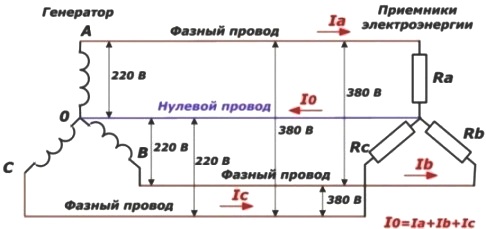
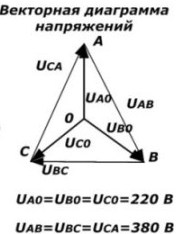
In each apartment or on the entrance scale a group of them with resistances “Ra”, “Rb”, “Rc” is supplied with phase voltage “A0”, “B0”, “C0”. Its value is usually nominal: 220 V. See also: What voltage in the electric network is optimal for the operation of household appliances
When connecting loads in phases current flows that is added to the neutral wire.
The circuit is balanced. There is no line voltage of 380 V in the electrical equipment of apartments.
What happens when a zero break?
Four-wire emergency operation mode:
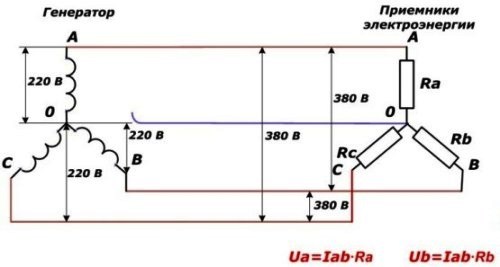
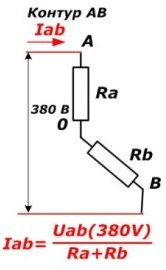
No current will flow in the neutral wire: the phase voltage is changed. All apartments have linear voltage applied according to the “Star Without Zero” scheme.
Consider the example of apartments "a" and "b". The electrical resistance of the devices Ra and Rb was successively summed, and the current Iab passed through it. Under his action, a voltage drop occurred in each apartment, proportional to the resistance of electrical appliances included in the network.
In any apartment, the owner himself manages the electricity. One turned off the excess light and sits in front of a desk lamp behind a book, or turned it off altogether, while the other has a TV, fridge, freezer and many other household appliances.
It is clear that the values of Ua and Ub can significantly differ from 220 V and will not be equal to each other. They can range from 0 to 380 V, depending on the device connection scheme in each apartment.
The error of the electricians (incorrect or incorrect connection of the neutral wire), unfortunately, is not the only possible cause of emergency situations. Zero breakage is possible without human intervention, for example, a zero wire break in the power cable, “burning” of zero at the substation, in the distribution and apartment panel.
The only way out of this situation is to quickly relieve tension. It is possible manually, but it is not reliable: it is very difficult to be in time. Automatic surge protection devices on the network do an excellent job of this.
To protect against an increase in voltage in the network when the neutral wire is broken, the minimum and maximum voltage releases are used, which expand the capabilities of circuit breakers, RCDs with the function of protecting against high voltage, stabilizers. Most often, special voltage relays are used to protect against emergency operation of this type.
Read also:
Voltage relay: what are, how to choose and connect?
Is it possible to minimize the number of failures of household appliances and equipment due to unstable voltage? It turns out you can. It is enough only to carry out the electrical installation of the voltage relay in the load circuit.
Two phases in your 220 volt outlet? This is more real than you think.
About a common wiring malfunction, when the 220 V phase is in both sockets of the socket. About why this is happening and why it is dangerous.
The voltage in a private house is 160 - 180 volts. What to do?
Low network voltage is a problem typical for households in the private sector. What actions must be taken to reduce the voltage drop in the electrical network.
Criteria for choosing a voltage stabilizer for the home
There are many ways to deal with the unsatisfactory quality of the voltage in the mains, but probably the easiest is to install a voltage stabilizer.
ABP for single-phase network and phase switch PF-451
The article describes a simple version of creating an ABP in a home electrical network based on special electronic devices manufactured by Euroavtomatika LLC.
RCD in two-wire: to put or not to put?
According to the PUE, the installation of RCDs is possible only in conjunction with the modernization of all electrical wiring with the transition of the TN-C system to TN-C-S. And what should unfortunate owners of apartments with old wiring do? Is a RCD installation a violation in this case?
See also at e.imadeself.com
:
